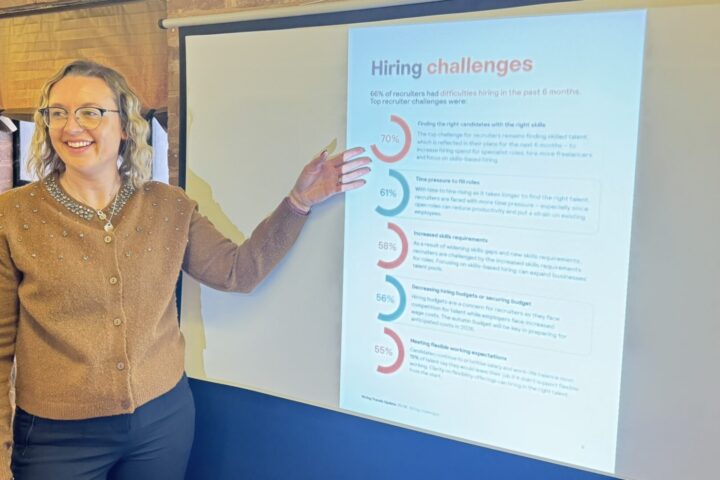Employer confidence has fallen to its lowest level outside of the pandemic, with redundancies at a decade-high and recruitment slowing across all sectors.
The latest Chartered Institute of Personnel and Development (CIPD) Labour Market Outlook showed that the net employment balance, a key measure of hiring confidence, has dropped from +21 to +13, marking the largest decline in over a decade.
In the private sector, confidence fell from +24 to +16, the lowest since 2014 outside of 2020.
The number of employers expecting to cut jobs in the next three months has increased from 11% to 16%, with 25% planning redundancies – the highest level recorded in a decade apart from the pandemic.
Recruitment also slowed, with 64% of employers planning to hire in the next quarter, down from 67% in the previous period.
Hard-to-fill vacancies remain widespread, affecting one in three employers; the public sector struggled the most, with 45% reporting hiring difficulties.
Nearly half of compulsory education providers and 46% of construction firms have persistent unfilled roles, while public administration, transport, and professional services also report significant hiring challenges.
Despite recruitment issues, pay growth remained subdued – the median basic pay increase for the next 12 months stands at 3%, unchanged from the previous quarter.
However, in the public sector, expected pay rises have dropped from 4% to 2.5%, which could further impact retention in key services.
Inflation, measured by the Consumer Prices Index including owner-occupiers’ housing costs (CPIH), stands at 3.5%, meaning real wages are not keeping pace with living costs.
The Autumn Budget has had a major impact on employment costs; the increase in employer National Insurance contributions, alongside business rate changes, is expected to significantly raise costs for businesses.
Two in five employers said these tax changes will have a large financial impact, and 42% planned to raise prices in response.
A third of employers expect to cut jobs or slow recruitment, while 24% plan to scale back investment.
SMEs were particularly affected, with 29% reducing their expansion plans.
Businesses are also re-evaluating workforce spending, with one in five planning to cut training budgets.
This raises concerns about future skills shortages, particularly in industries already struggling with recruitment.
Construction and manufacturing firms are increasingly turning to automation, with 31% and 34% respectively planning to introduce or expand automated processes.
In retail and hospitality, where employment costs are rising sharply, 68% of retailers and 59% of hospitality firms intend to raise prices to offset costs.
At the same time, 45% of hospitality businesses plan to reduce staff numbers.
Public sector employers, facing tight budgets and limited flexibility, are likely to respond by reducing staff numbers and cutting training.
However, increased Government funding is expected to provide some relief, with 58% of public sector employers believing it will help improve recruitment and 56% saying it could support retention over the next three years.
Mark Jones, reward and benefits partner at Isio, said: “With confidence falling sharply, its clear employers are still navigating a complex environment of rising costs, persistent skills shortages, and shifting workforce expectations.
“Small businesses, in particular, may struggle to expand their talent pools, which could limit long-term resilience.
“With private sector confidence at its lowest in a decade, excluding the pandemic, employers are facing increased pressure to remain competitive, particularly in attracting and retaining key talent.
“However, pay alone isn’t the answer.
“Employers who take a broader view, investing in benefits that support financial well-being, flexibility, and career development, will be better placed to sustain engagement and productivity in the long term.
“To build a workforce that is both diverse and sustainable, businesses must rethink their approach to recruitment and retention.
“Creating opportunities for those facing employment barriers – such as older workers, parent returners, and individuals with long-term health conditions – isn’t just about inclusion; it’s a practical solution to ongoing talent shortages.”
Catherine Foot, director of phoenix insights at Phoenix Group, said: “Today’s figures highlight ongoing challenges in the labour market.
“With recruitment intentions slowing, economic inactivity remains a concern.
“To help close the gap in economic inactivity, pay alone isn’t enough to support workers back into employment.
“We need to look at factors beyond pay – flexible work is the top priority for workers over 50 seeking to remain in work.
“While many still face barriers to re-entering the workforce, our Employment Index reveals that access to meaningful, well-paid employment varies significantly across the UK.
“This disparity can impact long-term financial security, particularly for those nearing retirement.
“Workers in regions with lower job satisfaction and financial security are less likely to save effectively for retirement.
“Flexibility is key to helping people stay in work longer to save and earn, but it’s not just about pay – it’s about creating an environment where people feel secure and supported in balancing work with health or caring needs.
“With vacancies declining, it’s important that roles provide flexibility, job security and inclusive recruitment.
“The Government’s Employment Rights Bill and Get Britain Working White Paper are steps in the right direction, but more action is needed to create a labour market that works for all.”

















